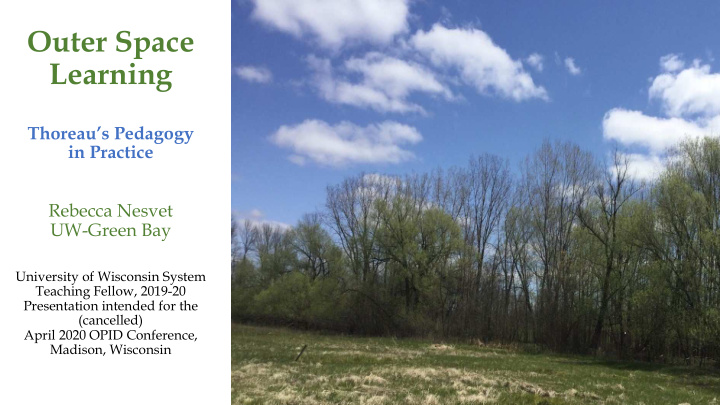



Outer Space Learning Thoreau’s Pedagogy in Practice Rebecca Nesvet UW-Green Bay University of Wisconsin System Teaching Fellow, 2019-20 Presentation intended for the (cancelled) April 2020 OPID Conference, Madison, Wisconsin
Problem? SOTL has been slow to explore the question of natural space in humanities teaching and learning. A 21 st century publication concerning campus learning environments assumes that a campus's "nonhuman components" consist of "parking lots, activity fields, artwork, and buildings," but nothing organic (Strange and Banning 18-19) and defines "the small, resident rural college" as a space at risk of having " nothing to do ," that "perhaps works best" as a learning environment "because of the fewer distractions demanding student time and energy" (142). Students in the humanities seem particularly likely to spend much of their class time in classrooms, which often are the ones in the campus's older buildings with fewer or smaller windows.
Exigency Today, the default learning space is the classroom, the LMS, or--in pandemic-stricken 2020-- the Zoom grid, framed by various improvised spaces in which students have taken refuge. This paradigm shift makes it imperative that we consciously design learning environments when we can.
Agent Provocateur? A model for this endeavor might be writer, activist, and sometime teacher Henry David Thoreau (1817-62). He lived and wrote for two years in a different kind of space: a wooded pond “a mile from any neighbor.” He hoped to engage with that natural environment, but his project evolved to critique his society from a distance and reflect on his goals and practice. What happens if we try his approach to learning space?
Method • “We [must] design activities and assignments that will produce direct, visible evidence of student thinking and learning” (Ciccone 18). • To achieve this, I assigned to my Fall 2019 English and Humanities capstone Thoreau’s Walden: or Life in the Woods and criticism. • They performed a walk (“sojourn”) and first-person free-write in the university Arboretum; • and, finally, completed original research and editorial projects which they presented together at a college-wide conference… • … enabling them to express outlooks on learning at various points during the term. • “The only way [to] learn if my students were beginning to think differently was to ask them directly” via “opportunities to reflect on their learning” (Ciccone 19). • I asked them to write about the course activities in a final reflective piece. They could opt whether to allow me to study this piece or not. I would not know what they chose until the end of the class, allowing no impact on grading. All 13 opted to participate.* *Two others also opted in but did not complete the course.
Results • “Using written work to answer questions about thinking raises the problem of validity,” while students often claim “dramatic” transformations that did not occur (Calder 113-5)… • … but I think that in the Thoreau students’ reflections, especially as contextualized by their previous work, specific detail about practice and insight suggests genuine transformation.
For Instance: Conference Challenge! • In December 2019, the 13 students presented at a public-facing undergraduate research conference. • Across the board, as outside observers not aware of my research casually remarked, the student presenters demonstrated not only knowledge of Thoreau's world and its significance to us today, but specificity, confidence, and passion. • Many students segued back and forth between their Arboretum sojourn and other kinds of research and creative activity, such as literary analysis and transcription and encoding of Thoreau's manuscripts in service of the Digital Thoreau ( www.digitalthoreau.org ).
In their own words: Final Reflections…
This capstone class was the first of my college courses in which part of the learning took place outside and particularly used the Arboretum as the “classroom” … the Arboretum walk provided me with the space to both separate myself from school and develop my ideas through unlikely inspiration. Rachel Scray “Sauntering in the wild” has made me much more interested in Thoreau The Natural Historian than Thoreau The Prescriptive Lecturer Cal Salmon
The arboretum also helped me appreciate Thoreau’s writing more. And for some reason, I felt like I was able to picture what he was telling us better than in prior readings. It’s almost as if I became more patient with his heavy description and maybe a bit appreciative. Tiffany Ambeau Without moments of decompressing, whatever that entails for a given person in a given moment, activity, especially intellectual activity, becomes insane Eliot Klutz
My experience walking through the woods also shaped my construction of my schema for the Digital Thoreau because the diversity of my thoughts showed me a few of the many places Thoreau might have gone. In his manuscript he included drawings, revisions, poems, and more, much like myself, and so elements and attributes to describe these are necessary. This can be understood through a reading of his works, but by understanding this through my own exploration, I found that the all the different elements are important in equal yet different ways because it is the combination of all of these things that creates the whole. Zachary Schneider
Conclusions The students’ writing, editing, group presentation, and final self-reflection combine to suggest connections between learning in non-classroom ‘outer spaces’ and the development of transferable research and writing skills, interest in the subject matter, mindfulness and confidence.
Calder, Lendol. “Student Think-Alouds: Making Thinking (Published) and Learning Visible,” in SOTL in Action: Illuminating Critical Moments of Practice, edited by Nancy L. Chick. Stylus, Works Cited 2018, pp. 109-118. Ciccone, Anthony. “Learning Matters: Asking Meaningful Questions,” in Chick, ed., pp. 15-22. Strange, C. Carney and James H. Banning. Educating by Design: Creating Campus Learning Environments that Work. Jossey-Bass, 2001.
Recommend
More recommend